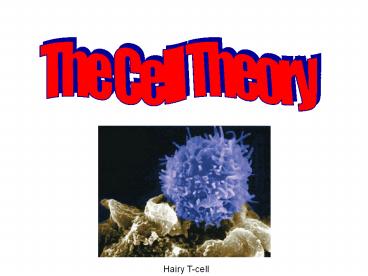The Cell Theory - PowerPoint PPT Presentation
1 / 30
Title:
The Cell Theory
Description:
Hairy T-cell Definition = Three part theory about cells 1. All living things are made of cells. Part 2 of the Theory 2. The cell is the basic structural and ... – PowerPoint PPT presentation
Number of Views:35
Avg rating:3.0/5.0
Title: The Cell Theory
1
The Cell Theory
Hairy T-cell
2
Definition
- Three part theory about cells
- 1. All living things are made of cells.
3
Part 2 of the Theory
- 2. The cell is the basic structural and
functional unit of life.
4
Part 3 of the Theory
- 3. All cells come from pre-existing cells.
yeast cells dividing
5
Who came up with this theory?
All plants are made of cells!
- 1. Schleiden (circa 1838)
Onion skin cells
6
Who came up with this theory?
All animals are made of cells!
- 2. Schwann
Human red blood cells
7
Who came up with this theory?
- 3. Virchow
All cells come from pre-existing cells!
8
How big are cells?
- Microscopic (mostly)
- Measured in microns µm
- (micrometers).
- A µm is one millionth of a meter
- 10-9 m one thousandth of 1 mm.
9
How big are cells?
- Smallest free-living cell
- Mycoplasma genitalium
- Size 0.2 to 0.3 µm
10
How big are cells?
- Bacteria e.g. Eschericia coli (aka E.coli)
- Size1 µm by 3 µm
11
How big are cells?
- Human red blood cell 8 µm in diameter
12
How big are cells?
- Largest cell on the human body
- ovum
- Size
- 1000 µm in diameter
- (1 mm)
13
How big are cells?
- Smallest cell in the human body
- sperm cell.
14
How big are cells?
- Largest cell with a metabolism
- Chaos chaos
- Size1-5 mm in length.
- common name
- Giant Amoeba
Chaos diffluens, is an amoeba closely related to
the giant amoebae
15
How big are cells?
- Largest cell yolk of an ostrich egg
16
Ostrich, egg, humans
17
Ostrich emerged from egg
18
How can we study cells?
- Problem
- They are microscopic!
- Solution
- Use a microscope!
19
Types of Microscopes
- Compound light microscope
- Light passes through lenses to magnify image up
to 1000X - Can observe living cells
20
Types of Microscopes
- 2. Electron microscope
- Uses a beam of electrons to magnify image
- gt 1000X
- Kills cells being observed
21
Common features of all cells
- Small size allows materials to move via
diffusion - Diffusion process by which molecules move from
levels of high concentration to levels of low
concentration until equilibrium is reached
22
Diffusion
- Google Image Result for http//www.indiana.edu/ph
ys215/lecture/lecnotes/lecgraphics/diffusion.gif
23
Common features of all cells
- 1. Cell Membrane selectively/differentially
permeable (lets some things in and out)
24
Common features of all cells
- 2. Cytoplasm semi-fluid material in which cell
organelles float
25
Common features of all cells
- 3. Nucleic acid containing genetic code
- Which nucleic acid?
- DNA
26
Common features of all cells
- 4. Cytoskeleton proteins that support the cell
- (Microtubules
- microfilaments)
27
Common features of all cells
- 5. Ribosomes
- make proteins
28
If Cells could be really big
Star Trek - The Immunity Syndrome
29
Bibliography
- http//www.hotlinecancer.com/?cat28
- http//news.bbc.co.uk/1/hi/sci/tech/4636121.stm
- http//www.thebacteriabusters.com/eColi.html
- http//www.lungcancer.co.uk/how.htm
- http//www.fi.edu/learn/heart/blood/red.html
- http//biology.about.com/library/weekly/aa091400a.
htm - http//www.pbs.org/wgbh/amex/babies/peopleevents/e
_ovum.html - http//www.dkimages.com/discover/Home/Animals/Bird
s/Growth-and-Development/Ostrich/Ostrich/Ostrich-1
5.html - http//www.flickr.com/photos/71751551_at_N00/12623291
63/ - http//commons.wikimedia.org/wiki/ImageOstrich_eg
g.jpg - http//www.mambalam.net/slideshow.php?set_albumNam
eAnimalia - http//strangebenevolent.blogspot.com/2007/07/meer
kats-and-ostriches.html - www.madsci.org/posts/archives/dec97/878139903.Cb.r
.html - http//en.wikipedia.org/wiki/Amoeba_proteus
- http//en.wikipedia.org/wiki/The_Immunity_Syndrome
_(Star_Trek
30
Bibliography
- http//www.pacpress.com/level3/micron.htm
- Google Image Result for http//www.indiana.edu/ph
ys215/lecture/lecnotes/lecgraphics/diffusion.gif - http//commons.wikimedia.org/wiki/ImageDiffusion.
jpg - http//library.thinkquest.org/C004535/cell_membran
es.html - http//sun.menloschool.org/cweaver/cells/e/riboso
mes/ - http//www.elmhurst.edu/chm/vchembook/580DNA.html
- http//sciencecity.oupchina.com.hk/biology/student
/glossary/cytoplasm.asp - http//www.uic.edu/classes/bios/bios100/lecturesf0
4am/lect06.htm































